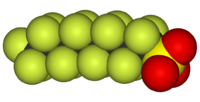
Photo from wikipedia
Antibiotics halt the growth of bacteria by targeting core, essential physiology that is required for life on standard microbiological media. Many more biochemical and virulence processes, however, are required for… Click to show full abstract
Antibiotics halt the growth of bacteria by targeting core, essential physiology that is required for life on standard microbiological media. Many more biochemical and virulence processes, however, are required for bacteria to cause infection in a host. Indeed, chemical inhibitors of the latter processes are overlooked using conventional antibiotic drug discovery approaches. Here, we use human blood serum as an alternative growth medium to explore new targets and compounds. High-throughput screening of genetic and chemical libraries identified compounds targeting biological activities required by Klebsiella pneumoniae to grow in serum, such as nucleobase biosynthesis and iron acquisition, and showed that serum can chemically transform compounds to reveal cryptic antibacterial activity. One of these compounds, ruthenium red, was effective in a rat bloodstream infection model. Our data demonstrate that human serum is an effective tool to find new chemical matter to address the current antibiotic resistance crisis.
Journal Title: Cell reports
Year Published: 2020
Link to full text (if available)
Share on Social Media: Sign Up to like & get
recommendations!